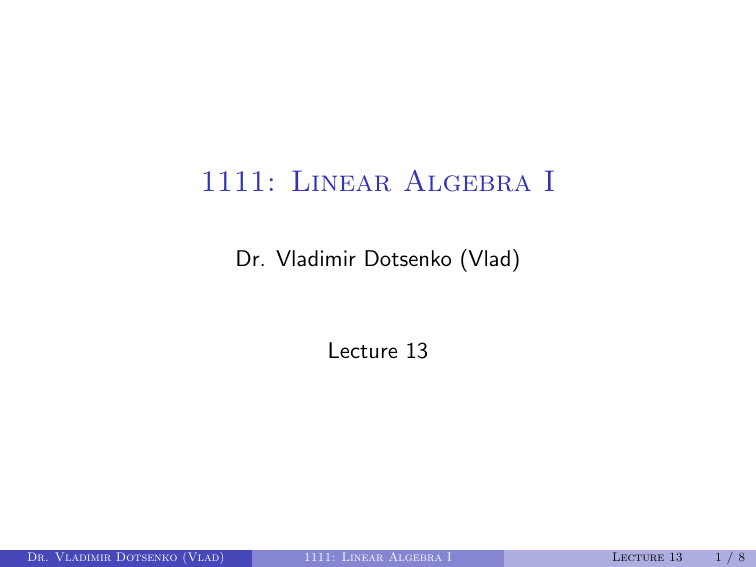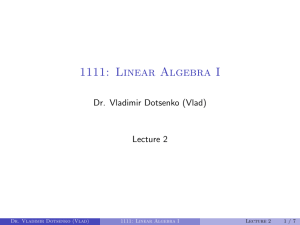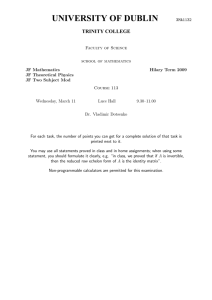1111: Linear Algebra I Dr. Vladimir Dotsenko (Vlad) Lecture 13 1 / 8
advertisement

1111: Linear Algebra I
Dr. Vladimir Dotsenko (Vlad)
Lecture 13
Dr. Vladimir Dotsenko (Vlad)
1111: Linear Algebra I
Lecture 13
1/8
Linear maps
A function f : Rn → Rm is called a linear map if two conditions are
satisfied:
for all v1 , v2 ∈ Rn , we have f (v1 + v2 ) = f (v1 ) + f (v2 );
for all v ∈ Rn and all c ∈ R, we have f (c · v ) = c · f (v ).
Talking about matrix products, I suggested to view the product Ax as a
function from Rn to Rm . It turns out that all linear maps are like that.
Theorem. Let f be a linear map from Rn to Rm . Then there exists a
matrix A such that f (x) = Ax for all x.
Proof. Let e1 , . . . en be the standard unit vectors in Rn : the vector ei
has its i-th coordinate equal to 1, and other coordinates equal to 0. Let
vk = f (ek ), and let us define a matrix A by putting together the vectors
v1 , . . . , vn : A = (v1 | v2 | · · · | vn ). I claim that for every x we have
f (x) = Ax. Indeed, we have
f (x) = f (x1 e1 + · · · + xn en ) = x1 f (e1 ) + · · · + xn f (en ) =
= x1 Ae1 + · · · + xn Aen = A(x1 e1 + · · · + xn en ) = Ax.
Dr. Vladimir Dotsenko (Vlad)
1111: Linear Algebra I
Lecture 13
2/8
Linear maps: example
So far all maps that we considered were of the form x 7→ Ax, so the result
that we proved is not too surprising. Let me give an example of a linear
map of geometric origin.
Let us consider the map that rotates every point counterclockwise through
the angle 90◦ about the origin:
Since the standard unit vector e1 is mapped to e2 , and e2 is mapped to
0 −1
−e1 , the matrix that corresponds to this map is
. This means
1 0
x1
0 −1
x1
−x2
that each vector
is mapped to
=
. This can
x2
1 0
x2
x1
also be computed directly by inspection.
Dr. Vladimir Dotsenko (Vlad)
1111: Linear Algebra I
Lecture 13
3/8
Linear independence, span, and linear maps
Let v1 , . . . , vk be vectors in Rn . Consider the n × k-matrix A whose
columns are these vectors.
Let us relate linear independence and the spanning property to linear
maps. We shall now show that
the vectors v1 , . . . , vk are linearly independent if and only if the map
from Rk to Rn that send each vector x to the vector Ax is injective,
that is maps different vectors to different vectors;
the vectors v1 , . . . , vk span Rn if and only if the map from Rk to Rn
that send each vector x to the vector Ax is surjective, that is
something is mapped to every vector b in Rn .
Indeed, we can note that injectivity means that Ax = b has at most one
solution for each b, which is equivalent to the absence of free variables,
which is equivalent to the system Ax = 0 having only the trivial solution,
which we know to be equivalent to linear independence.
Also, surjectivity means that Ax = b has solutions for every b, which we
know to be equivalent to the spanning property.
Dr. Vladimir Dotsenko (Vlad)
1111: Linear Algebra I
Lecture 13
4/8
Subspaces of Rn
A non-empty subset U of Rn is called a subspace if the following
properties are satisfied:
whenever v , w ∈ U, we have v + w ∈ U;
whenever v ∈ U, we have c · v ∈ U for every scalar c.
Of course, this implies that every linear combination of several vectors in
U is again in U.
Let us give some examples. Of course, there are two very trivial examples:
U = Rn and U = {0}.
The line y = x in R2 is another example.
Any line or 2D plane containing the origin in R3 would also give an
example, and these give a general intuition of what the word “subspace”
should make one think of.
The set of all vectors with integer coordinates in R2 is an example of a
subset which is NOT a subspace: the first property is satisfied, but the
second one certainly fails.
Dr. Vladimir Dotsenko (Vlad)
1111: Linear Algebra I
Lecture 13
5/8
Subspaces of Rn : two main examples
Let A be an m × n-matrix. Then the solution set to the homogeneous
system of linear equations Ax = 0 is a subspace of Rn . Indeed, it is
non-empty because it contains x = 0. We also see that if Av = 0 and
Aw = 0, then A(v + w ) = Av + Aw = 0, and similarly if Av = 0, then
A(c · v ) = c · Av = 0.
Let v1 , . . . , vk be some given vectors in Rn . Their linear span
span(v1 , . . . , vk ) is the set of all possible linear combinations
c1 v1 + . . . + ck vk . The linear span of k > 1 vectors is a subspace of Rn .
Indeed, it is manifestly non-empty, and closed under sums and scalar
multiples.
The example of the line y = x from the previous slide fits into both
contexts. First of all, it is the solution set
to the system of equations
x
Ax = 0, where A = 1 −1 , and x =
. Second, it is the linear span
y
1
of the vector v =
. We shall see that it is a general phenomenon:
1
these two descriptions are equivalent.
Dr. Vladimir Dotsenko (Vlad)
1111: Linear Algebra I
Lecture 13
6/8
Subspaces of Rn : two mainexamples
1 −2 1 0
, and the corresponding system
3 −5 3 −1
of equations Ax= 0. The reduced row echelon form of this matrix is
1 0 1 −2
, so the free unknowns are x3 and x4 . Setting x3 = s,
0 1 0 −1
−s + 2t
t
, which we can represent as
x4 = t, we obtain the solution
s
t
−1
2
0
1
s
1 + t 0. We conclude that the solution set to the system of
0
1
−1
2
0
1
equations is the linear span of the vectors v1 =
1 and v2 = 0.
0
1
Consider the matrix A =
Dr. Vladimir Dotsenko (Vlad)
1111: Linear Algebra I
Lecture 13
7/8
Subspaces of Rn : two main examples
Let us implement this approach in general. Suppose A is an m × n-matrix.
As we know, to describe the solution set for Ax = 0 we bring A to its
reduced row echelon form, and use free unknowns as parameters. Let xi1 ,
. . . , xik be free unknowns. For each j = 1, . . . , k, let us define the vector
vj to be the solution obtained by putting the j-th free unknown to be
equal to 1, and all others to be equal to zero. Note that the solution that
corresponds to arbitrary values xi1 = t1 , . . . , xik = tk is the linear
combination t1 v1 + · · · + tk vk . Therefore the solution set of Ax = 0 is the
linear span of v1 , . . . , vk .
Note that in fact the vectors v1 , . . . , vk constructed above are linearly
independent. Indeed, the linear combination t1 v1 + · · · + tk vk has ti in the
place of i-th free unknown, so if this combination is equal to zero, then all
coefficients must be equal to zero. Therefore, it is sensible to say that
these vectors form a basis in the solution set: every vector can be obtained
as their linear combination, and they are linearly independent. However,
we only considered bases of Rn so far, and the solution set of a system of
linear equations differs from Rm .
Dr. Vladimir Dotsenko (Vlad)
1111: Linear Algebra I
Lecture 13
8/8





